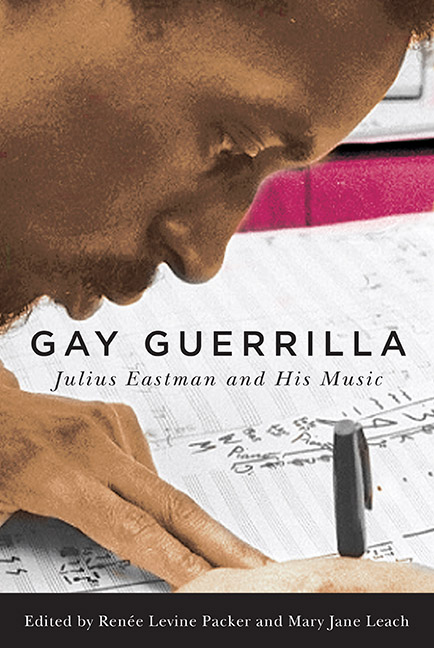Book contents
- Frontmatter
- Contents
- Foreword
- Acknowledgments
- Introduction: Julius Eastman and His Music
- 1 Julius Eastman, A Biography
- 2 Unjust Malaise
- 3 The Julius Eastman Parables
- 4 Julius Eastman and the Conception of “Organic Music”
- 5 Julius Eastman Singing
- 6 An Accidental Musicologist Passes the Torch
- 7 A Flexible Musical Identity: Julius Eastman in New York City, 1976–90
- 8 Evil Nigger: A Piece for Multiple Instruments of the Same Type by Julius Eastman (1979), with Performance Instructions by Joseph Kubera
- 9 A Postminimalist Analysis of Julius Eastman’s Crazy Nigger
- 10 “That Piece Does Not Exist without Julius”: Still Staying on Stay On It
- 11 Connecting the Dots
- 12 Gay Guerrilla: A Minimalist Choralphantasie
- Appendix: Julius Eastman Compositions
- Chronology
- Selected Bibliography
- List of Contributors
- Index
- Eastman Studies in Music
8 - Evil Nigger: A Piece for Multiple Instruments of the Same Type by Julius Eastman (1979), with Performance Instructions by Joseph Kubera
Published online by Cambridge University Press: 26 May 2021
- Frontmatter
- Contents
- Foreword
- Acknowledgments
- Introduction: Julius Eastman and His Music
- 1 Julius Eastman, A Biography
- 2 Unjust Malaise
- 3 The Julius Eastman Parables
- 4 Julius Eastman and the Conception of “Organic Music”
- 5 Julius Eastman Singing
- 6 An Accidental Musicologist Passes the Torch
- 7 A Flexible Musical Identity: Julius Eastman in New York City, 1976–90
- 8 Evil Nigger: A Piece for Multiple Instruments of the Same Type by Julius Eastman (1979), with Performance Instructions by Joseph Kubera
- 9 A Postminimalist Analysis of Julius Eastman’s Crazy Nigger
- 10 “That Piece Does Not Exist without Julius”: Still Staying on Stay On It
- 11 Connecting the Dots
- 12 Gay Guerrilla: A Minimalist Choralphantasie
- Appendix: Julius Eastman Compositions
- Chronology
- Selected Bibliography
- List of Contributors
- Index
- Eastman Studies in Music
Summary
My approach to dissecting Julius Eastman's Evil Nigger, in this case for multiple pianos, is in the form of an interpretation and description, rather than a strictly theoretical analysis. I also refer to Joseph Kubera's “General Instructions” (which may be found at the end of this chapter), that he put together as performance notes for the pianists with whom he has performed the piece.
Overview
In general, the piece has many elements associated with the minimalist genre. It has short tonal phrases, played in a steady tempo, that are repeated many times. Its overall structure and harmonic language, however, are too quirky to completely fall into that mold. It contains very dramatic harmonic passages, which eventually lead to a nontonal disparate arrhythmic pointillistic texture of pitches of long duration that seemingly lead nowhere. It uses minimalist gestures and gradually abandons them for a free-floating ambient atmosphere. The piece proceeds in precisely notated clock time and takes twenty-one minutes and five seconds to perform. Each player needs a stopwatch, or some mobile device, showing the passing time in large numbers so that the changes happen precisely. Although it is not absolutely necessary, the piece should have a conductor in order for it to proceed smoothly. The recording of the piece on New World Records (Julius Eastman, Unjust Malaise) employs four pianos, but as Eastman has explained elsewhere, it could be performed by any group of instruments of the same type, such as strings or clarinets, but would take more players—anywhere from ten to eighteen.
Structural Segments
Musically, the piece proceeds with almost constant sixteenth notes played at quarter note = 144 throughout, until the last few minutes. There are twenty-nine sections in all. Kubera's excellent set of instructions for performers encompasses most of the issues discussed below.
Many sections are subdivided into shorter time segments, so the numbering of events can be confusing at times. The note events can be played in any octave, and are not limited to the range of the written note. This implies that the performers can decide ahead of time which octave they will play in any given section.
- Type
- Chapter
- Information
- Gay GuerrillaJulius Eastman and His Music, pp. 131 - 139Publisher: Boydell & BrewerPrint publication year: 2015
- 1
- Cited by



